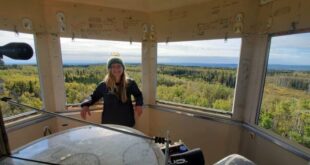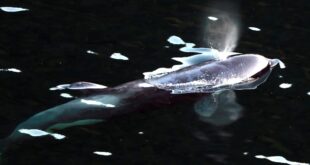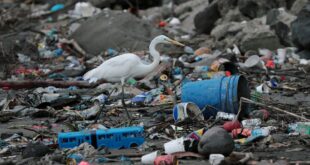The prehistoric lizard is related to the Gila monster.
Not far from the bank of Wapiti River, just 11 kilometres from Grande Prairie, there’s a paleontological goldmine: an ancient riverbed that contains fragments of skeletons of hundreds, possibly thousands, of animals from the late Cretaceous period, some 70 million years ago.
Discovered in 2014, the bonebed is known as a DC site, or, more formally, Wapiti Unit 3.
It yields a wide range of fossils and teeth from many species of prehistoric vertebrates, said Corwin Sullivan, a University of Alberta paleontologist who does fieldwork in Grande Prairie.
“We have small dinosaur material from there. We have mammal teeth, we have turtles, we have a few crocodilian teeth, we have fish material,” he said.
In this bonebed, paleontologists found remains of a relatively small prehistoric lizard — a type of animal whose fossils are found infrequently.
The discovery allows researchers to paint a more accurate picture of the biota in the Grande Prairie area some 70 million years ago. The findings were first described in a paper published in Geosciencesin November.
In the DC site, paleontologists discovered an ankle bone and a skull bone on two consecutive days, July 28 and 29 in 2017. The ankle bone didn’t tell researchers much, but the skull bone allowed them to identify it as a lizard, thanks to the bony knobs fused with the top of the skull, called osteoderms.
Smaller fossils found infrequently
Most of the time when paleontologists find fossils, they come from larger animals, such as dinosaurs, Vavrek said. Their bones are more robust and tend to preserve “a bit better,” said Matthew Vavrek, a Grande Prairie paleontologist who co-authored the paper. Big fossils are also just easier to see.
Smaller animals, such as lizards, turtles and crocodiles played important roles in the prehistoric ecosystem, Vavrek said, but because their bones are smaller and didn’t preserve nearly as well as bones of bigger animals, we have poor records of them.
This hinders our understanding of what the natural world looked like at that time.
“It’s important to appreciate that ancient ecosystems, like our modern ones, have animals of a variety of different sizes,” said James Gardner, a paleoherpetologist with the Royal Tyrrell Museum who was not involved in the research.
“If you were to go out into a modern day environment here in Alberta, and only look at the larger animals, you get things like bison and elk, some of the bigger birds, some of the bigger fish,” he said.
“But you’d be missing all the the small mammals, the birds, the frogs, the snakes — all those that are important parts of the ecosystems.”
Ancient lizard has modern cousins
The lizard belongs to a group of animals called Monstersauria. It could be similar to a modern-day monitor lizard in appearance, Vavrek said. The lizard was about one metre in length, Sullivan said. Sullivan is also one of the study’s co-authors.
The lizard occupied an ecological niche resembling that of similarly-sized animals today, eating small prey, including small mammals, whose fossils were found in the Wapiti formation, Vavrek said.
Gila monster, a venomous lizard that resides in the southwestern United States and northwestern Mexico, is a living member of the Monstersauria group. A desert-dwelling animal, it doesn’t tolerate cool temperatures very well.
It’s prehistoric relative, on the other hand, was much more adapted to a somewhat cooler climate, Gardner said, though it was still warmer than today. The climate was also more “equitable,” Sullivan said, with lesser temperature gradient between the poles and the equator. The fossils found represent the northernmost record of any definitive late Cretaceous monstersaur to date, the paper states.

Finding the skull bone is itself valuable, Sullivan said.
“Having a relatively complete one is actually kind of exceptional and special.”
“There’s just a bit of wow factor associated with this large, unusual lizard that’s related to the modern Gila monster.”
Sullivan pictures the area where the lizard lived as a “wet, swampy forest.” Collecting more fossil plants from the site will help scientists further understand the environment in the Cretaceous Grande Prairie, he said.
“It hasn’t really been an area of focus up to now, and I think it should be, given the paleo-environmental importance of of the flora.”
ABOUT THE AUTHOR

Journalist
Dennis Kovtun is a journalist with CBC Edmonton, covering a variety of stories in the city. Reach him at dennis.kovtun@cbc.ca.
*****
Credit belongs to : www.cbc.ca
 Atin Ito First Filipino Community Newspaper in Ontario
Atin Ito First Filipino Community Newspaper in Ontario






